The stongest motivation for this project is to be able to produce sufficient quantities of charcoal of good quality that can be ground up into granular carbon and used in a drinking water purification system I am designing.
Currently we drink rainwater, graciously purified by the hydrologic cycle. However, Thailand suffers an extended dry season and often rainwater supplies run out and the farm resorts to purchasing drinking water from the village. I will design a sand and carbon filtration system that will allow the community to drink water from the irrigation canals. This water has been tested and shown to contain small quantities of microorganisms as well as pesticide and fertilizer runoff from the nearby fields. A well-designed sand and carbon filtration system should remove these contaminants.
The first step has been to construct a shelter for the kiln. Here I've set up a timber frame just uphill from the kitchen.

Locating the kiln near the kitchen evinces the permaculture principle of locating often-used features near often-occupied areas. Stoking the kiln fire takes some babysitting for the first 1 - 2 hours; this can be done around meal times when the kitchen is heavily occupied. Also, the product -- charcoal -- will be used as a cooking fuel (in addition to it application to water purification); the shelter design thus includes a storage space for the chracoal.
The design will also include a bin for storing firewood to be pyrolized in the kiln and for stoking the fire. This bin will be on the south face of the structure to promote maximal insolation -- this will help with the drying of the wood prior to use.
Fixin' to get my thatch on...


Thatch monkey, that funky monkey...
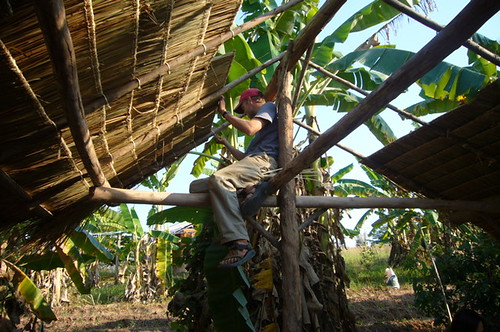
Couldn't have done it without Leah...
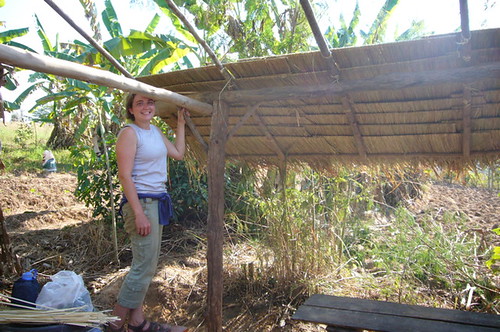
Finished thatch roof...
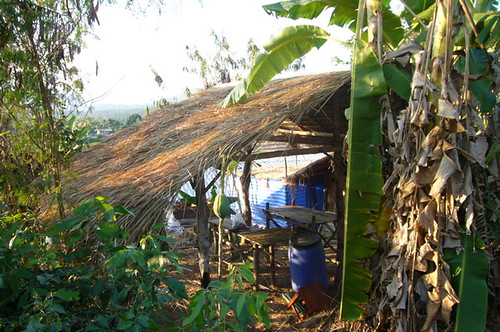
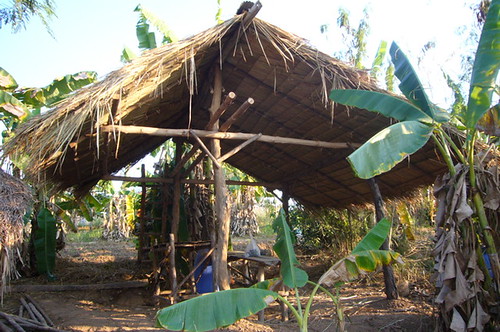
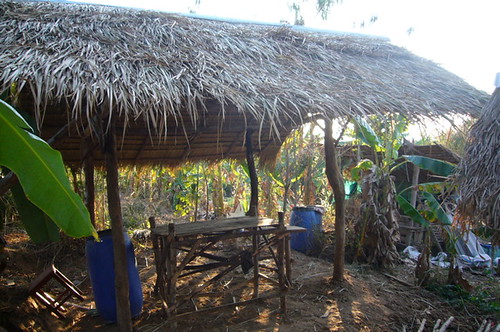
Pi Dtai and Pi Jeni taught us the old school way to thatch a roof -- with tie strips cut from fresh bamboo. To make these, you get a big, sharp knife and a long shank of bamboo. You cut the bamboo in half lengthwise, then keep cutting by half until you get very thin strips that can be twisted around the thatch panels and rafters to hold down the roof.
I tried to cut some strips myself, but I was very slow and I kept cutting myself both with the knife and the bamboo! I decided with the thumb incident I had bled enough for one week and so I asked Pi Jeni to cut all the stips for me. He is like some kind of bamboo slicin' ninja. He turns out perfect strips so quickly, and never cuts himself. Amazing! Turns out, none of the bamboo houses in his village use a single nail in their construction -- they are completely tied together with bamboo strips. So he's got some experience making these things...
Seriously folks, fresh cut bamboo is some sharp stuff. Pi Dtai said that back in the day when a woman gave birth they would use a piece of fresh cut bamboo to cut the umbilical cord.
No comments:
Post a Comment